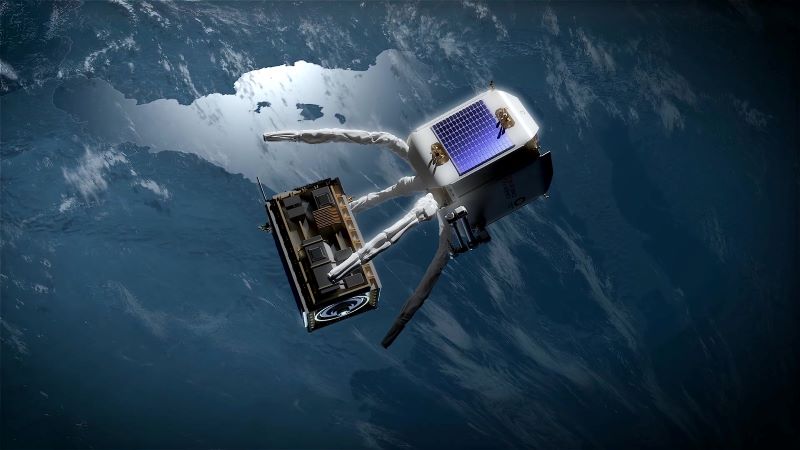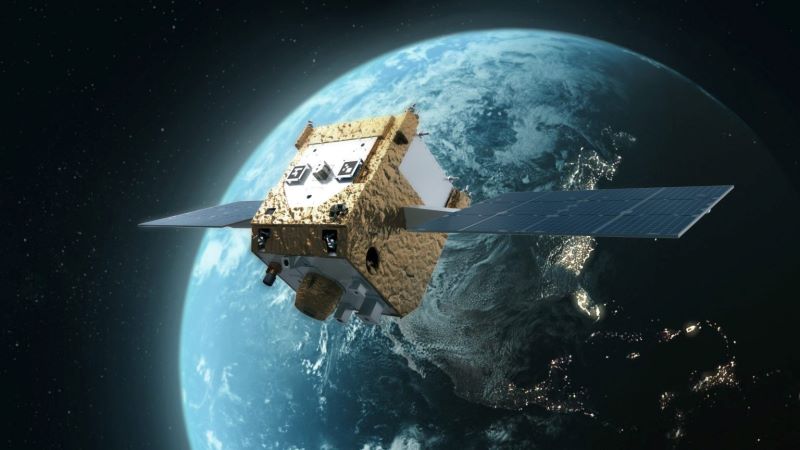It was aloft for just half a minute before being destroyed. But the launch by Isar Aerospace saw Western Europe take another step in joining a rush to put things into orbit.
The German space startup fired its test vehicle from a launch site in the far north of Norway expanding the range of polar and Sun-synchronous orbits in a market that has seen the number of satellites launched into orbit soar over the past five years to more than 2000. But one of the planned launches from Norway’s Andøya spaceport will carry a pair of small satellites that will try to find out how big a problem the launches around the world so far have caused.
Short of achieving escape velocity, what goes up will come down eventually thanks to the minuscule drag from the edges of Earth’s atmosphere. But while it is up there, any object is a potential obstacle to all the other orbiting traffic. Dead satellites and spent rocket launchers have lingered for years in a band 800km above sea level and will probably stay for another hundred before the tiny amount of atmospheric drag slows them enough to re-enter and burn up.
According to Holger Krag, head of the ESA's space-debris office, agencies around the world are tracking 40,000 objects larger than a smartphone. One of them was a tool bag lost by astronauts working on the International Space Station (ISS) in November 2023. Others are large chunks from a 2009 collision between an active Iridium telecom satellite and a dormant Soviet military payload. “We can even predict where they will be tomorrow, and that's quite important because we can avoid collisions by flying our spacecraft around them,” Krag says.
What worries operators like ESA is that as the debris mounts up, so satellites will have to engage in numerous avoidance operations. Predictions put this problem decades into the future, but there is a growing risk from smaller objects that cannot be tracked from the ground.
Almost a decade ago, a 2mm fragment that might have been orbital debris, or a natural micro-meteoroid struck a solar panel on ESA’s Copernicus Sentinel-1A. The energy was enough to tilt the satellite and break off some of the panel itself. “The impact has generated fragments that are now visible from the ground. And these fragments have already triggered collision alerts,” says Krag.
Those small fragments do not just come from collisions. “We have several hundred events in the past where space objects literally break up. That is because of residual energy on board, fuel, pressure in tanks, even charged batteries,” Krag notes, adding that about ten of those explosions occur each year.

Above an artist's impression of the CLEAR UKSA Mission deorbiting a defunct satellite
Delivering greater accuracy
Data collected from impacts on the Space Shuttle and other missions led ESA to estimate there are more than a million bigger than a centimetre and some 130 million bigger than a millimetre. The Arctic University of Norway’s QBDebris mission that should launch from Andøya before 2027 aims to deliver a more accurate estimate. The pair of satellites that use cubesat payload designs will scan for debris using off-the-shelf radar systems similar to those used by self-driving cars. By working as a pair, the researchers behind the project hope to work out the changing densities of fragments bigger than a millimetre in 3D space as the craft cross different orbit zones.
QBDebris will join a growing number of projects that range from large-scale ground-based radar installations to student initiatives, designed to improve space agencies’ understanding of how bad the situation is and point to ways to deal with it.
The MOVE III project, run by students at the Technical University of Munich, will use a sensor on its front surface to detect sub-millimetre dust using impact ionisation. And the German Space Agency is developing three laser-ranging sensors that should go into action in 2027, joining an existing ground-based radar system called GESTRA.
The next question is what to do about the junk they all find. NASA published a report last year that examined the cost of trying to remove the debris and ways to limit its creation. The team found shielding against particles, even up to 1cm across, could deliver a good payoff for the most vulnerable satellites.
Similarly, designing satellites that have built-in methods for deorbiting once their missions are over provides the most cost-effective approach to preventing further uncontrolled proliferation. However, the study found that trying to use methods to stop satellites blowing up in the first place looks to be more expensive than the long-term cost of dealing with the consequences.
Even if the space community embraces the principle of cleaning up after itself, the remaining debris will continue to pose a problem. This is where another group of missions come in. They cover every package size, from tiny nanosatellites to payloads weighing hundreds of kilograms. Some have already completed. Several years ago, Surrey Space Centre’s RemoveDebris mission used cubesats launched from the ISS to test how well nets and dragsails might work to capture and pull failed probes out of orbit.
ESA is continuing with the ClearSpace-1 mission, which will try to grab and pull down a defunct Belgian cubesat that orbits about 200km higher than the ISS. “It's like an octopus with four arms,” says ESA director-general Josef Aschbacher, describing the capture robot that lies at the heart of the mission.

The Astroscale refueller is set to be launched later this year (2025)
An open question is how much fragmentation such robotic arms themselves will cause, with some teams proposing the use of soft, tentacle-like materials to minimise the risk to the target satellite. These will be far more difficult to control and may simply fail to succeed in capturing anything.
The ClearSpace-1 mission will see both satellites destroyed as they re-enter the atmosphere. Other approaches to deorbiting might not need that level of sacrifice. One of the more promising methods for larger fragments is to use a high-power laser. A simulation by Liam Pieters and Ron Noomen, researchers at the Technical University of Delft, showed how a 20kW laser shooting 30 pulses a second at up to 500km away could work on fragments measuring 10cm or less. The bad news is that this method may not work well with tumbling objects because they don’t present a stable target for the energy buildup needed.
For larger payloads, the Earth’s magnetic field provides the source of another path to orbital braking. In this scenario, a nanosatellite deployed by a longer-lived parent that would attach itself to a target and deploy a kilometre-long conductive tether. This electrodynamic tether increases the Lorentz force that acts on charged particles in a magnetic field. As long as the tether stays beneath the target, the force pulls it towards the ground.
Parent satellites able to launch deorbiting payloads might not be dedicated to clearing space junk. They could stay aloft to perform repairs to functioning craft. Having demonstrated methods for docking with craft magnetically, initially intended for deorbit operations, Astroscale has developed a 300kg craft that it hopes will ferry a tank of hydrazine fuel to a US military satellite in geostationary orbit next year. The ClearSpace consortium aims to pursue a similar path in future missions, including one to deorbit two UK satellites after the ESA project.
George Freeman, who was minister for space in the previous government, argues the UK could take advantage of increasing interest in cleaning up Earth orbit. Such systems provide opportunities for electronics design as users look for more advanced ways to control satellites in orbit, deploy robotic manipulators and incorporate high-power lasers.













